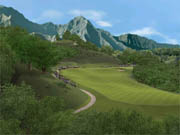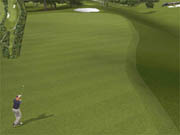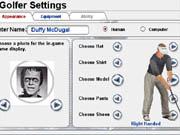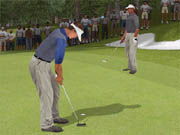Tiger Woods might be the world's most famous golfer, but his real-life success hasn't gone very far toward making serious golf-sim fans embrace the EA Sports line bearing his name. But that could all change with Tiger Woods PGA Tour 2002, and the biggest reason why can be summed up in two words: Headgate Studios. The creator of Sierra's brilliant PGA Championship Golf series, Headgate was tagged by EA Sports to develop the 2001 edition of Tiger Woods PGA Tour--though anyone familiar with both Headgate's previous efforts and the earlier Tiger Woods games could easily see that the developer must have had instructions not to stray too far from the look and feel of earlier PGA Tour installments.

But that sure isn't the case with PGA Tour 2002. It seems that just about every aspect of the game's design has undergone some type of change, from the radically improved swing interface and the use of 3D golfer animations instead of digitized motion-capture footage, to a powerful camera option that gives you unlimited access to the gorgeously rendered courses. EA Sports clearly wanted to move the franchise toward producing a more realistic golfing experience--it even bit the bullet and left Michael Jordan off the roster of golfers--while taking care not to intimidate novice and casual fans with the myriad shot setup options of the Links games. The result? A game that's authentic enough for hard-core fans, yet one that even newbies can quickly grasp and enjoy.
Potential buyers might be disappointed that the game ships with only six courses, but a closer inspection reveals that things aren't as bad as they seem. The half-dozen venues (Pebble Beach, Royal Birkdale, Spyglass Hill, the Prince Course at Princeville, Poppy Hills, and the venerable TPC at Sawgrass) are undisputed classics of course design and cover a broad spectrum of environments. Still, six does seem a bit meager--until you consider you can import not only all the PGA Tour 2001 courses, but also any user-created courses for both PGA Tour 2001 and PGA Championship Golf 2000. Add in a wonderful course architect tool with a friendly "new course wizard" option, and it's obvious that any shortage of links will soon be rectified.
You can compete as 11 PGA Tour pros in addition to Woods, with the field featuring golfing luminaries such as Singh, Janzen, Parnevik, Faxon, Leonard, Montgomerie, Calcavecchia, and Appleby, among others. You'll also find less-famous pros Steve Stricker and Notah Begay III, one of Woods' teammates at Stanford. (It's worth noting these are just the pros rendered with 3D models--choose "PGA Tour" for your opponents and you'll see 134 other PGA golfers on the leaderboard.) You can set the pros to computer control, you can adjust their ability ratings in eight categories, and you can equip human- and computer-controlled golfers with different types of clubs, shafts, and balls.
It's hard to fuss about the selection of pros here, but once you get them out on the course you'll find that some of the faces on the 3D character models could have definitely used a bit more polish. You'll also find that Headgate might have skimped a bit on the number of different character animations, especially for putting--all the models stroke the ball with a somewhat jerky movement that almost makes them look as if they're in pain. The good news is that you'll be able to make this discovery thanks to a flexible camera system. Right-clicking and dragging the mouse will rotate and pan around a scene, while the camera menu lets you change the altitude, angle, and direction of the perspective--if you can't get a good idea of how you should play your next shot with this camera system, chances are you never will. The auto-cam, which kicks in after each shot, seems comparable to a TV-style presentation, but actually it's often better than what you see on the tube because it doesn't zoom in too closely on the ball.

Gamers who want to create their own PGA persona rather than play as one of the tour pros will discover one of the few weak points in the game: There are only a handful of character models to choose from, and three of those are female. It's nice that EA Sports tipped its hat to female fans by including models for them, but surely it doesn't seem like it would have been too tough to add at least two or three additional male models for the guys who'll make up the huge majority of buyers.
A baker's dozen of game types are available when playing a single round. Besides the prerequisite stroke, match, and skins, you'll find Stableford, alternate shot, greensome, bloodsome, scramble, and three varieties of four-ball play. Two interesting additions are skills competition and shoot-out--the first challenges you with specific types of shots, while the other is a "last man standing" affair where the player with the worst score is eliminated before proceeding to the next hole.
Most players will discover these new modes in the game's tour challenge, a series of 15 scenarios where you compete against the pros to earn experience points. Beyond the shoot-out and skills competition, the tour challenge scenarios revolve around shooting a certain score on a set of holes--all the par threes at Pebble Beach, for instance. You could create these same scenarios yourself during single-game setup, but the inclusion of these fun little time killers is still worthwhile.

PGA Tour 2002 features three tour seasons--amateur, PGA, and EA Sports--but to compete in the last two you're supposed to head to Q School and earn your tour card. Sounds fair enough, but there's one problem: it seems that every Q School session takes place in gale-force winds after a heavy rain. That's a bit of an exaggeration, but on the game's "tour" difficulty setting (second hardest), the wind at both Q Schools was always over 20 mph and the greens were so slow you'd think they'd been hosed down with molasses overnight. Players who want to compete in these two seasons without enduring Q School can edit the seasons, but that means opening every event in the season and changing the eligibility to "all." It's certainly doable and not all that time-consuming, but wouldn't it have been simpler to include an option to globally change eligibility for a season?
After you've finally settled on a game type and hit the links, you'll be presented with an entirely new in-game interface--one that bears a not-so-coincidental resemblance to the one Headgate designed for PGA Championship Golf. The rainbow-shaped aiming marker of earlier Tiger Woods games that showed you your shot's flight path and landing point is gone--now you must rotate your golfer to reflect which direction you'll be hitting the ball. For the actual stroke, you'll be using a triple click, a double click (for pure beginners since accuracy is guaranteed), or the acclaimed TrueSwing movement-based mouse interface first introduced in PGA Championship Golf. Headgate created a dumbed-down version of TrueSwing for PGA Tour 2001 (where it became "Pro Swing"), but those seeking realism spurned it because it was impossible to hook or slice the ball and 300-yard drives were the order of the day. That's been fixed, and while the TrueSwing here feels slightly forgiving, it's still light-years ahead of the previous shot interface.
PGA Tour Golf's graphics, while not initially as impressive as what you'll see in Links 2001, will soon grow on you--especially after you take time to admire things like the wonderfully detailed reflections on the surfaces of water, and the amazingly crisp shadows on the fairway and greens. Perhaps the most impressive visual effect in the game is the waves at Pebble Beach--this is the most convincing rendering of any body of water we've ever seen in a golf sim. The graphics come with a price, though--on a 1.1GHz Celeron with a TNT2 card, the frame rate dropped to a maddening crawl even with detail settings greatly reduced. Things ran considerably smoother after we upgraded to a GeForce2 Ti, but even so we weren't able to run the game smoothly in 32-bit color. In short, you'll need a fairly boss system to see this game in its true graphical glory.

But this isn't the first game to make strenuous system demands in exchange for a great gaming experience, and it won't be the last. What's more troubling are the conditions EA has set up for the game's online play mode. The manual rather tersely states that "Online gameplay for Tiger Woods PGA Tour 2002 will be available only through March 1, 2003. Subject to online terms of use, all features may not be available at the time of purchase." It's hard to accept that a company--especially a big one like EA--would cripple a game's multiplayer mode by limiting how long it will work on its proprietary matching service.
After all, by next year, PC golf sim fans might not have a lot of options. With the Jack Nicklaus line long gone and the PGA Championship Golf series fading into oblivion, it looks as though the only real choices left are Tiger Woods PGA Tour 2002 and whatever Links bundle, if any, Microsoft decides to put out this year. For what it's worth, EA's latest sim has the goods to keep you occupied at least until the next installment.